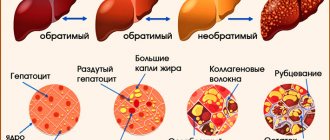4369
0
Primary liver cancer (that is, a cancer process that initially began in this organ) is quite rare. It accounts for only 10% of all diagnosed cases of malignant lesions of this gland. The remaining 90% of cases are metastases in the liver, which entered it from another primary cancer site located in other internal organs. The exception is African countries, since these countries have a high incidence of hepatitis, as a result of which the primary tumor is often found in liver cells. In most cases, metastases spread through the blood or lymph from:
- Breasts, that is, the mammary gland (in both men and women);
- Stomach;
- Pancreas;
- Esophagus;
- Lungs and pleura;
- Colon;
- Melanomas (a type of skin cancer).
Most metastatic disease originates from the gastrointestinal tract. This is due to the fact that the gastrointestinal tract is anatomically close to the liver.
Causes
The liver is the main cleanser of the body, taking full responsibility for processing accumulated poisons, waste, and toxins. The organ is literally riddled with blood vessels, veins, and arteries. If a malignant tumor settles and grows in the body, then it is impossible to avoid the migration of cancer cells to the liver in sufficient quantities.
Metastases are a secondary form of cancer. They can penetrate the liver organ when the primary tumor is localized in the intestines, lungs, stomach, or mammary gland. Less common, but migrate from the kidneys and genitals.
Attention! Primary oncological process in the liver is a rare occurrence. It accounts for no more than 10% of all known malignant neoplasms. Most often this is a secondary cancer. This is explained by the fact that the organ has a well-developed blood supply system. Every minute up to 1.5 liters of blood passes through it. 70% comes through the portal vein from the intestine, 30% from the hepatic artery. Then both flows mix and flow through the inferior vena cava to the heart.
It is for the liver, taking into account the peculiarities of blood circulation, that the hematogenous route (with lymph) of penetration of metastases is characteristic. This is the most common site of localization of hematogenous tumor cells due to the structural features of the organ with the property of retaining them. In most cases, liver metastases come from the gastrointestinal tract due to anatomical proximity.
Also from the affected part of the intestine (for colorectal cancer), pelvis, peritoneal cavity, pancreas, esophagus (for gastrointestinal tumors). Less often, but even from the oral cavity, pharynx, ovaries, bladder.
Diagnostics
Metastases to the liver indicate progression of cancer
Diagnosing cancer does not take such a long period of time, especially when it comes to the third and fourth stages, because there are already direct manifestations and symptoms. That is why, when cancer cells are detected in the body, each person is checked for the presence of metastases. And first of all they look at the liver, since it is to this organ that frequent metastasis occurs.
First of all, a person is prescribed tests, the results of which will show a deficiency or excess of certain components that may indicate the presence of this problem. But no such analysis will be completely reliable without additional studies, such as ultrasound, magnetic resonance imaging, and computed tomography with contrast injection.
The most accurate results will be obtained by computed tomography with contrast, since it can show the exact lesion and its approximate size. After all these studies have shown a positive result, a mandatory liver biopsy must be performed. It is carried out under full control using an ultrasound machine, as this procedure is quite dangerous. A histological examination of metastatic cells is also done to determine the type of cancer cells.
Very often, doctors may be unable to accurately diagnose the presence of metastases in the liver. This happens when a patient is diagnosed with cancer, but it is not possible to recognize whether there are metastases or not. In this case, the only thing you can rely on is the results of blood tests, as well as the increase in bilirubin content in the serum.
Also, a very important point in diagnosing liver metastases is the precise determination of the location of the primary tumor. This is necessary in order to begin timely treatment and remove cancer cells. It is simply impossible to remove metastases without affecting the main focus in any way, since there is a huge probability of relapse.
Almost every cancer patient notices symptoms of metastases in the liver, since it is to this organ that the most common spread of secondary nodes occurs. If treatment is not started on time, this can lead to death, and in the very near future, since cancer cells multiply very quickly and cause irreparable harm to the body.
The following video will tell you about the treatment of liver cancer and liver metastases using the CyberKnife radiosurgical system:
Metastasis in the liver is quite common, since the organ has a rich vascular network and intense blood circulation. More than 1.5 liters of blood passes through the liver per minute, so the risk of spread of metastases by hematogenous route is quite high.
According to the ICD, the code for such a disease is C78.7 (secondary malignant hepatic neoplasm). Cancer tumors of the breast, pancreas, lungs, etc. are especially likely to metastasize to the liver.
There are different classifications of liver metastases.
- Based on their location, liver metastases are divided into bilobar (affecting 2 lobes of the organ) and unilobar (affecting 1 lobe).
- Depending on the quantitative indicators, metastatic liver tumors can be multiple (tens of tumor nodes) or single (when there are 2-3 nodules).
Photo of liver metastases
The formation of metastatic foci in the liver occurs due to the elimination of cancer cells through the circulatory system.
If metastasis to the liver structures is distant in nature, then this indicates the neglect of the oncological process, which has already reached stage 4. In such a situation, there is practically no chance of cure.
The cause of metastatic tumors in liver tissue is usually primary malignant tumors localized in structures such as:
For stage 4 liver cancer
Any hepatic malignancy is difficult to treat, especially in the last stages.
Stage 4 malignant process in liver tissues is characterized by irreversibility, i.e. it is impossible to completely cure such oncology, because the formation grows uncontrollably, and cancer cells actively spread throughout the body.
This is an extremely dangerous degree of the disease, with a high risk of death.
A liver affected by tumors can fail at any time. The fourth stage of renal oncology manifests itself clearly. I am concerned about intense pain and manifestations of liver failure.
Pancreatic tumors
The pancreas is the most important digestive organ. When its structures are affected by cancer, metastases spread primarily to the liver, lungs and kidneys.
The reason for such metastasis is the close functional and anatomical connection between these organs. There is even a special concept - the formation of the hepatopancreatoduodenal zone.
These include neoplasms of the liver, gall bladder and pancreas, duodenum and bile ducts. Metastasis to the liver in pancreatic tumors begins at stage 4.
Cancer of the cecum and rectum
Colorectal cancer often progresses silently, and in the first stages of pathology it can resemble a gastrointestinal disorder.
A feature of this type of oncology is the characteristic ability to metastasize primarily to the liver.
Survival for colorectal cancer with liver metastases is approximately 35%.
Although the final prognosis depends on the degree of metastatic damage to the hepatic structures.
Without a primary focus
Metastasis from an undetected maternal tumor is by no means uncommon. Quite often, such metastatic formations are detected in the liver, where they metastasize from mammary glandular tissues or organs of the gastrointestinal tract.
Such metastases also do not appear immediately, but only in the last stages of oncology. Typically, such metastasis is detected by computer or ultrasound diagnostics, and is treated by resection with preoperative chemotherapy.
Features of the development of metastases in the liver
Metastases attack the liver in stages. Malicious cells:
- separated from the affected organ, in which intensive infiltration occurs;
- migrate into the blood or lymph, circulating along the riverbed;
- attach to the vascular wall;
- the liver takes root, beginning to form a new tumor-like focus.
The liver is the most favorable organ for the development of cancer cells and the formation of a secondary focus. This is due to the structural features of the organ and the location of multiple sinusoidal capillaries in the cavity. It is the liver that takes on the neutralizing function when replaced healthy cells enter in different ways: lymphogenous, hematogenous, implantation, retrograde, perineural.
Reference! When doctors suspect cancer, they first examine the liver. After all, every 3rd patient experiences metastatic lesions of this organ, regardless of the location of the primary tumor. The process of metastasis can begin with almost any type of cancer. Even if it is not possible to accurately identify the location of the main tumor focus at an early stage, the appearance of metastases in the liver will allow an accurate diagnosis to be made accurately.
The main types of cancer that metastasize to the liver
Cancer cells migrate from the affected organ to a healthy organ in an orthrograde, retrograde manner (in the opposite direction of the natural blood flow).
Metastasis in the liver is observed when diagnosed - primary cancer of almost any organ (with the exception of the brain) in the case of oncells leaving its limits: intestines, stomach, lungs, mammary gland, skin, kidneys, genitals, ovaries, bladder, prostate gland.
Secondary lesions in the liver are formed from screenings of tumor cells of the mother tumor and multiply up to 0.5 mm in size. The frequency of penetration of metastases from the primary focus in descending order, see the table:
| Organ | % |
| colon (colon, sigmoid, rectum) | 15-35 |
| stomach | 17-85 |
| esophagus, pancreas | 40 |
| lungs | 15-75 |
| breast | 20-65 |
| ovaries, kidneys, cervix, oral cavity, larynx, melanomas | to 10 |
Symptoms of metastasis in stage 4 cancer
The quality of life of a cancer patient depends on the number and extent of metastasis and the severity of the primary tumor.
The approach of death in stage IV cancer is indicated by an increase in the clinical picture:
- Yellowness of the skin is a sign of blockage of the biliary tract, creating problems for the digestion and absorption of fats;
- Severe headaches with metastasis to the brain can only be eliminated with narcotic analgesics. The intervals between periods of drug administration are constantly shortening as education increases;
- Frequent fractures and paralysis of the limbs are symptoms of weakness of bones and soft tissues;
- Thrombosis, strokes - problems with blood clotting;
- Constant inflammation of the lungs appears when the activity of the immune system decreases;
- Gangrene, ischemic stroke, arterial thromboembolism can cause rapid death if a clot enters the pulmonary artery;
- An increase in the degree of anemia will cause failure of the cardiovascular system.
Severe pain due to a cancer tumor forces a person to choose whether to start taking narcotic analgesics, which shorten life, or to endure it. Additional complications create difficulties that are difficult to bear mentally and physically - hallucinations, intestinal constipation, muscle atony, vomiting with blood, bleeding from the rectum, intracerebral hemorrhage.
An extreme degree of exhaustion (cachexia) leads to a weakening of physiological processes and increasing mental disorders.
Prognosis and treatment of liver metastases
Many factors influence a person's life expectancy. Type of neoplasm, localization, prevalence. According to statistics, after identifying metastases, people do not live more than one and a half years, but modern medical technologies are gradually increasing the time. European oncology clinics perform liver resection, which can significantly improve survival. If you radically eliminate the primary focus, then there is a chance of getting rid of cancer forever. Difficulties arise in selecting the optimal donor in a short period of time, while the primary tumor is small and there is only one metastasis. Practice shows the effectiveness of transplantation only for colon cancer, which is not invasive.
In most cases, therapy is carried out with antitumor drugs that inhibit the activity of tumor cells. A large formation extends beyond the organ, so surgery is performed. If large volumes of the organ are affected, only transplantation will be effective. Achieving survival for 5 years can be considered successful. At the same time, most patients are able to lead a normal lifestyle and go to work.
In Russia, 40% of operated people have a survival rate of 5 years. In 30% of patients, life expectancy is 3 years. With cirrhosis, these deadlines are quite difficult to achieve, but oncologists sometimes succeed.
Surgeries are not performed for multiple metastases. In such a situation, symptomatic treatment and chemotherapy for malignant neoplasms are prescribed. In the later stages, the prognosis is unfavorable. Five-year survival rate for this pathology is observed in only 2% of people.
Combined treatment includes ablation, vascular embolization, radiation therapy, and chemotherapy.
Local destruction of cancerous formation is carried out by medical alcohol, cryodestruction (frozen gas), and high-energy exposure. The manipulation is carried out under the control of ultrasound scanning. The treatment method is rational for tumors less than 3 cm in diameter.
Embolization involves the introduction of a special substance into the cancer to stop the microcirculation of the tumor. The method is used for lesions with a diameter of no more than 5 cm.
Chemotherapy with Nexavar and Sorafenib destroys malignant cells with minimal effect on healthy tissue. For liver metastases, such therapy is ineffective.
Radiation therapy with X-rays is carried out to suppress the activity of the malignant focus. Minimal irradiation of healthy tissue is achieved through precise targeting of the beam to the tumor node.
To summarize, with small intrahepatic metastases there are no symptoms. An advanced neoplasm has severe symptoms that increase before death. Conservative treatment does not bring relief. The frequency of administration of narcotic analgesics to eliminate pain increases.
Oncological diseases still occupy one of the highest places on the list of diseases from which people die. In most cases, this occurs because cancer cells metastasize to other vital organs. Most often it is the liver, pancreas, and lungs. Often, a person does not notice any special symptoms of cancer until it reaches the third stage and metastases appear. Metastases in the liver manifest themselves with the most severe and obvious symptoms.
Liver metastases symptoms
There is an opinion that the liver does not hurt. This is partly true, because at the initial stage metastases go unnoticed. It may only periodically cause weakness, fever, or loss of body weight for no reason.
Characteristic symptoms of the pathological process, which appear gradually, in an increasing manner:
- vomiting, nausea;
- pain in the right hypochondrium;
- feeling of heaviness in the stomach;
- skin itching due to intoxication of the body, pallor of the integument;
- discharge of light feces, dark urine;
- jaundice (acquisition of mucous membranes and skin of a yellow tint if bile pigments enter the blood);
- bleeding;
- ascites with the accumulation of free fluid in the peritoneal cavity.
With metastases in the liver, there are certain symptoms that cannot be ignored:
- loss of appetite, severe thinness;
- severe pain just below the right rib;
- bouts of vomiting, nausea;
- severe intoxication of the body;
- heart rhythm failure;
- heartache.
Symptoms of metastases and primary cancer are often combined: nausea + weight loss + sudden weight loss, indigestion + abdominal cramps.
Important! A signal that the tumor is progressing quickly and increasing in size is a feeling of heaviness in the right hypochondrium. This first call cannot be missed and ignored. You need to see a doctor and get examined urgently.
The liver is designed in such a way that healthy tissues, with minor damage to the parenchyma, will continue to perform their functions. Clinical symptoms appear only when the tumor reaches a large size, i.e. at stages 2-3. The main symptoms depending on the cancer of the affected organ according to the table:
| Organ | Signs |
| breast | Lumps in the breasts, redness, swelling of the skin, lemon peel formation, erosive nipple discharge |
| lungs | Cough, shortness of breath, coughing up blood, chest pain |
| Intestines | Bloating, nausea, vomiting, constipation |
| Pancreas | Jaundice, pain. Cancer often disguises itself as diabetes and has no specific symptoms. |
Liver metastases symptoms before death
Signs appear at the 4th advanced stage, when multiple metastases provoke the development of multiple organ failure with penetration into several internal organs at once. The main symptoms before death with liver metastases :
- severe weakness;
- exhaustion, dehydration;
- severe drowsiness;
- feverish condition;
- temperature fluctuations caused by circulatory disorders, thermoregulation;
- loss of appetite, sudden weight loss;
- shortness of breath, sharp breathing, moist rales (with pulmonary edema), inability to clear throat;
- decrease in blood pressure;
- swelling of the peritoneum with accumulation of fluid in the free cavities;
- lethargy, apathy, lethargy;
- slow, slurred speech;
- loss of orientation in space, hallucinations, delusions (a person forgets information, does not recognize relatives);
- renal dysfunction, diuresis with a decrease in daily urine volume.
With pre-death metastases in the liver, a person begins to eat little. Sometimes he even refuses to drink water. Stops moving and getting out of bed due to weakness. When certain brain structures are dysfunctional, mental changes occur. Periods of lethargy are replaced by lethargy and apathy. Bowel movements and urination become uncontrollable. Half-asleep people lose control of their psyche, begin to distance themselves from others and feel the end approaching. Hope for recovery is fading. At this time, it is important for relatives to be nearby, distract them, talk about the best moments in life, provide comfortable conditions, ease the patient’s torment, without ceasing to give hope for recovery until the last day.
Manifestations of impending death in liver cancer
Single metastases are not a death sentence. Due to the high restorative capacity of the organ, small lesions are asymptomatic. Only after an increase in size do clinical symptoms appear. At an earlier stage, the clinic appears after blockage of the intrahepatic bile ducts.
Multiple liver metastases - symptoms before death:
- Increasing fatigue and drowsiness are not eliminated by conservative medications. It is impossible to wake up a sick person in the morning, which is due to a lack of vitamins and mineral components. Lack of water disrupts the blood supply to internal organs due to thick blood. If a cancer patient lies in bed for a long time in the morning, it is a sign of lack of strength. At this time, a person hears what is happening around, you can talk to him;
- Lack of nutrients does not increase appetite. The amount of food is reduced daily. Malignant neoplasms “force” you to give up even water. When oncologists collect anamnesis, patients describe the condition as “the stomach does not digest meat”, “the intestines are sulking from porridge.” In severe cases, the skill of chewing food particles is lost;
- Lack of water, vitamins, amino acids, and energy leads to a decrease in muscle activity. The patient cannot turn over to the other side on his own. Physical weakness increases over several weeks until complete immobility;
- Disruption of the intercostal muscles is characterized by Cheyne-Stokes respiratory activity. Frequent shallow breathing is a harbinger of death. Patients breathe loudly and wheeze. Symptoms lead to death within a few days or weeks;
- The imminent death is indicated by the coldness of the fingers. The panic state is explained by the centralization of the blood supply - from peripheral to central organs (brain and heart);
- Lack of blood supply to the brain tissue leads to neurological disorders - disorientation in space, confused consciousness and speech. Conversation with the patient is meaningless due to incoherence and intermittency of statements. After taking drugs to improve cerebral microcirculation, a person returns to consciousness for a short period of time;
- Swelling of the lower extremities before death is a standard situation arising from failure of the functioning of internal organs and accumulation of water in the legs;
- The veins fill with blood. The formation of large blue spots is a typical manifestation of the condition. Uneven blood circulation leads to primary damage to the venous network of the lower extremities;
- Before death approaches, interest in loved ones and the surrounding environment is lost. The patient is isolated from the situation, goes inside himself;
- Kidney damage and neurogenic disorders cause urination problems. Increased vascular permeability of the urinary tract is determined by the reddish tint of urine;
- Jaundice due to blockage of the bile ducts cannot be cured with cholelytic drugs and has a progressive course;
- Pain in different parts of the body occurs with concomitant bone metastases;
- Increased vascular permeability and problems with blood clotting lead to stroke and muscle paralysis;
- Anemic syndrome in tests may be due to a violation of the hematopoietic function of the bone marrow.
Additional symptoms appear when mental symptoms are added - hallucinatory syndrome, delirium, muscle paralysis.
Liver metastases treatment
If secondary tumors are detected, when developing effective treatment tactics, doctors take into account the degree of intensive growth and the size of the tumors. If earlier treatment at the 4th stage of cancer practically did not bring the expected results, a person lived in agony for no more than 1 year, today effective minimally invasive methods have been developed that can significantly increase the survival rate:
- chemotherapy;
- surgical intervention;
- radiation therapy.
Attention! For liver metastases, treatment with folk remedies is not carried out. This can become not only ineffective, but also dangerous and significantly worsen the situation.
Surgical removal of a section of an organ
The operation is still widely practiced by oncologists. Prescribed according to indications for patients:
- liver metastasis without damage to the vascular system;
- single cancer cells;
- individual foci outside the organ.
If the secondary tumor is located under the liver capsule and does not grow rapidly, it can be removed together with a small area of the organ. Although even after surgery, large nodes can metastasize again. The method is ineffective if the main tumor is not completely removed.
The prognosis for the location of cancer cells in both lobes of the organ is unfavorable. The tumor, even after removal, can begin to recur, especially if it is not possible to retreat from its border to a sufficient distance.
Chemotherapy
The treatment method is indicated for rapid tumor growth. Pros:
- the ability to administer medications directly into the vessels supplying blood to the liver to achieve high concentrations;
- significant reduction in the negative impact of chemical components on the body;
- obstacle to further progression of metastases;
- removal of small tumors.
If the patient is experiencing severe pain, then narcotic painkillers are also prescribed.
Reference! It is chemotherapy that often manages to achieve sustainable tumor regression and stabilize the patient’s condition. Medicines are prescribed even in the most advanced cases of metastases, stage 4 liver cancer, when treatment does not bring the desired results. However, it may slightly extend the lifespan.
One of the modern methods of treatment is chemoembolization with the introduction of oily cytostatic compounds, which begin to release components for the destruction of tumor tissue.
Radiation therapy
X-rays are used. Treatment is provided by their properties that regulate pathogenic cells upon penetration into tissues.
options for liver metastases :
- Outer. The device is applied to the patient's body to affect the tumor.
- Three-dimensional conformal. Allows you to irradiate only cancer cells without affecting healthy tissue
- Stereotactic. A malignant neoplasm is influenced by a powerful targeted-focused beam of radiation.
Radiosurgery
Radioactive isotopes are used to inject into the lumen of the vessel, gradually destroying the tumor. To access the hepatic artery, a catheter is inserted into the femoral vessel.
Reference! Due to exposure to a radioactive isotope, the neoplasm stops feeding and affects healthy organs. The method allows you to stop the growth of pathogenic cells, prevent their destruction, and achieve good results in treatment. Although it often causes pain. Additionally, patients are prescribed anesthetics.
Electororesection of nodes
A nano-knife is used to seal tissue if necessary to get to hard-to-reach areas. Especially when the tumor is located near large vessels.
There is no bleeding during surgery. The integrity of the blood vessels is not compromised.
Liver transplantation
A radical method of surgery, in which the liver is subject to resection and is replaced with a donor organ. Indications:
- ineffectiveness, impossibility of using other methods;
- the presence of one or several foci of new growths up to 7 mm in size;
- absence of tumor growth into the vascular wall.
Therapy methods can increase the survival rate to 5 years. Unless, of course, complications follow after surgery to remove the primary tumor.
Targeted therapy
Drug treatment comparable to chemotherapy. Targeted drugs with a targeted effect on the tumor are used:
- do not lead to adverse reactions;
- do not have a detrimental effect on cell health.
However, it becomes useless if the cancer cells completely stop responding to chemicals.
New treatments
Radiofrequency ablation
Modern surgery allows this method to be used for metastatic liver disease. A source (electrode) of high-frequency radiation is brought through the skin and muscles to the tumor node. The accuracy of the electrode location is controlled by electroanatomical mapping. Radiation directly affects the metastasis and destroys tumor cells. At the same time, the impact on surrounding tissues and the risk of bleeding are minimal. The procedure can also be performed under local anesthesia.
Chemoembolization of tumor
Used when ablation is contraindicated. Having provided access to the vessels feeding the tumor, a chemotherapy drug is injected into them through a needle. This substance “solders” the walls of the arteries, blood stops flowing through the vessels into the metastasis, and without nutrition the tumor node dies. Aseptic necrosis and death occurs.
Targeted therapy with biologics
Specific drugs obtained as a result of high-tech synthesis (Sorafenib, in particular) selectively act specifically on cancer cells. Substances toxic to tumor cells accumulate in them and prevent further growth of cancerous foci. The method is used in complex therapy, as an addition to other treatment methods, in the presence of contraindications to radical treatment.
Life expectancy with metastases
The prognosis of life expectancy for liver metastases depends entirely on:
- location, type of neoplasm;
- degree of development of the disease;
- immune status, age of the patient;
- the presence of concomitant pathologies.
It is difficult to say how many people live with liver metastases at the 4th stage of cancer. The more there are, the worse. If proper treatment is not carried out, then with multiple pathological cells, life expectancy will not be more than 0.5 years. The course of chemotherapy will add up to 1.5 years. In case of surgical intervention, survival rate is 3 years for:
- the initial stage of metastasis - 73% of cases;
- Stages 2-3 – 29-60%, respectively.
If the primary malignant lesion is detected early or there are no relapses after surgery, the duration increases to 3.5-5 years.
Reference! With liver metastases, a prognosis cannot be made in advance. According to statistics, women survive more often than men. Age doesn't have much of an impact. Much depends on the size of the secondary formation and the location of the main node. The most favorable prognosis is for colon cancer after resection of the main, secondary tumor node. Things are worse in the presence of metastases not only in the liver parenchyma, but also in the corresponding organs. Especially if pathological cells spread to the lymph nodes and bone tissue.
What is the danger of metastases?
Metastatic liver damage affects the functioning of the entire body. Protein exchange occurs in this organ. fats and carbohydrates, bile is secreted, the blood is cleansed of poisons and toxins. Multiple metastases in the liver do not allow it to perform its functions. As a result of the gradual growth of tumors, dangerous changes occur:
- toxins and poisons circulate in the blood without being able to leave the body;
- the outflow of bile is blocked, which provokes the development of jaundice;
- blood circulation is disrupted - blood fills the collaterals (bypass paths), which are located on the anterior wall of the abdomen;
- due to stretching of the walls of blood vessels, they become weak, bleeding appears in the abdominal cavity;
- the fluid penetrates into the abdominal cavity and is there in a free state, which is dangerous for the development of peritonitis.
In addition, in the presence of metastases, therapy of the underlying tumor becomes difficult. Chemotherapy treatment is toxic to the body and puts a lot of stress on the liver. Even a healthy organ needs recovery after taking a course of medications.
If metastases are in the liver, drug treatment is much more difficult to tolerate.
Diagnostic methods
Diagnostic options to identify the type and size of a tumor in the liver:
- MRI;
- Ultrasound;
- computed tomography biopsy blood test.
Metastases in the liver are detected first by ultrasound, in particular the size of tumor nodes in the parenchyma. Although not informative enough. To make an accurate diagnosis and develop treatment tactics, additional examinations are prescribed.
Laboratory
Blood is drawn: general, biochemical, and for tumor markers. At the initial stage of oncology, a general blood test is the most informative. The fact that the tumor is progressing and metastases appear will be indicated by:
- exceeded ESR;
- a sharp decrease in hemoglobin readings;
- platelets will be in small quantities, and the number of leukocytes, on the contrary, will be too increased.
Of course, a general blood test cannot accurately confirm the diagnosis. After all, deviations from the norm may not be solely due to cancer. Often another test is prescribed - blood biochemistry. This will help make a more accurate diagnosis, identifying an increase in the content of bilirubin, urea, and the like.
Tests for tumor markers make it possible to conduct a more accurate and effective examination, and an analysis for ACE is also considered no less informative.
Instrumental
Instrumental methods:
- CT scan to detect any type of cancer.
- Ultrasound to visualize neoplasms in the liver tissue.
- MRI to find differences between malignant and benign tumors with the possibility of using contrast and obtaining greater accuracy.
- Angiography. Evaluates the state of blood flow, vascular system, and the duration of pathological transformations. The puncture is collected minimally invasively or during surgery.
The liver is an organ in which favorable conditions are created for the development of metastases. Despite the advancement of medicine, it is almost impossible to recognize the process of metastasis at the initial stage. Replaced cells in the organ begin to pose a mortal threat and require timely examination and removal.
The manifestation of metastases is an alarming sign, and only a correct, timely approach to treatment will significantly prolong life. The main thing for patients with cancer is not to give up. There must be faith in the success of treatment until the last moment.
Oncology treatment
Surgical removal
Metastases in the liver can be cured surgically, but the success of surgery and the prognosis for a full recovery depend on the degree of neglect of the pathology and the general condition of the patient. When metastases are single, and the functioning of the organ is not impaired, laparoscopy is performed, during which malignant nodes are removed, after which treatment with chemicals and radiotherapy is prescribed. Surgery is also justified when a solitary metastasis is detected in intestinal oncology, but an important condition is the operability of the main tumor and the absence of metastasis to other organs and systems.
In case of widespread spread, radical resection is performed to remove the affected part of the organ. If oncology has affected more than 75% of the liver, there is no point in treating the patient surgically. In this situation, palliative therapy is carried out, the main goal of which is to relieve pain and improve the moral state of a person before death. At the last stage of progression, the patient had an average of 3-6 months to live.
Treatment
It is always necessary to select the most optimal treatment algorithm based on a large amount of input data and pursuing the main goal - to prolong the patient’s life for an extremely long period. Therefore, the primary determining factors are always: the general condition of the patient, the extent of the tumor, previous treatment, concomitant diseases, the histological form of the tumor and the presence of certain mutations.
In case of secondary liver cancer, results can be achieved exclusively by the method of simultaneous therapy (parallel treatment of the primary tumor) in combination with chemotherapy. If the surgeon has serious concerns about the operation, local methods are offered as an alternative: radiofrequency and microwave ablation (cauterization within healthy tissue) or cryodestruction (freezing of metastases).
The diagnostic results are carefully studied, after which either the need for surgery or its complete futility due to massive damage becomes obvious. However, there are exceptions here too. When there are many metastasized foci, but technically they can still be removed, a course of chemotherapy is preliminarily prescribed to assess the patient’s prospects and the feasibility of surgical treatment . And if positive dynamics occur, a date for the operation is set.
Depending on a number of individual factors, metastases are removed in one of the following ways:
- Laparoscopy - removal under visual control of a video camera by introducing an endoscope into the abdominal cavity.
- Laparotomy - removal of lesions by cutting the abdominal wall.
- Radiofrequency ablation - cauterization of lesions by inserting a catheter with an electrode heated to 110 degrees.
- Microwave ablation is a percutaneous method using a laparoscope. Cauterization with microwave radiation.
- Cryodestruction is the freezing of lesions with highly cooled liquid nitrogen using a cryoprobe under ultrasound control.
Reference ! Preoperative chemotherapy is often the only compelling argument for radical surgery.
However, in some cases, it is the course of preliminary chemotherapy that causes significant difficulties already during the operation. This refers to the so-called “lost” metastases. Other provoking causes of this problem include incomplete diagnosis, lack of intraoperative ultrasound CT and insufficient experience of the surgeon in liver resection. The problem is acute for lesions smaller than 1 cm.
If necessary , up to 80% of the liver can be removed without threatening the patient's life . The entire missing volume will be restored on its own over the next 3-4 months . The total duration of the longest operation rarely exceeds 1.5 hours. The next 8-10 days must be spent in a hospital under close supervision.
Danger of metastases
The process of metastasis negatively affects the performance of the organ. Active spread of metastases is fraught with the following consequences:
- there is a delay in the processing of vitamins and microelements;
- organs are not provided with glucose;
- hormones are not produced;
- liver enzymes, proteins and fats are not produced.
In addition, metastases can affect the spine, leading to disability. In the event of an emergency, immediate surgical intervention may be required.










